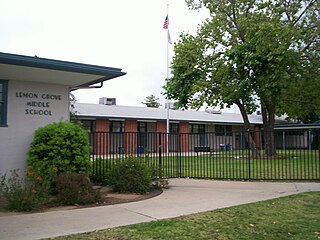Brown v. Board of Education of Topeka, 347 U.S. 483 (1954), was a landmark decision of the U.S. Supreme Court ruling that U.S. state laws establishing racial segregation in public schools are unconstitutional, even if the segregated schools are otherwise equal in quality. The decision partially overruled the Court's 1896 decision, Plessy v. Ferguson, which held that racial segregation laws did not violate the U.S. Constitution as long as the facilities for each race were equal in quality, a doctrine that had come to be known as "separate but equal." The Court's unanimous decision in Brown and its related cases paved the way for integration, was a major victory of the civil rights movement, and a model for many future impact litigation cases.

Lemon Grove is a city in San Diego County, California, United States. The population was 27,627 at the 2020 census, up from 25,320 at the 2010 census.
Milliken v. Bradley, 418 U.S. 717 (1974), was a significant United States Supreme Court case dealing with the planned desegregation busing of public school students across district lines among 53 school districts in metropolitan Detroit. It concerned the plans to integrate public schools in the United States following the Brown v. Board of Education (1954) decision.

Desegregation busing was a failed attempt to diversify the racial make-up of schools in the United States by sending students to school districts other than their own. While the 1954 U.S. Supreme Court landmark decision in Brown v. Board of Education declared racial segregation in public schools unconstitutional, many American schools continued to remain largely racially homogeneous. In an effort to address the ongoing de facto segregation in schools, the 1971 Supreme Court decision, Swann v. Charlotte-Mecklenburg Board of Education, ruled that the federal courts could use busing as a further integration tool to achieve racial balance.

Tape v. Hurley, 66 Cal. 473, (1885) was a landmark court case in the California Supreme Court in which the Court found the exclusion of a Chinese American student from public school based on her ancestry unlawful. The case effectively ruled that minority children were entitled to attend public school in California. After the Court's decision, San Francisco Superintendent of Schools, Andrew J. Moulder, urged the California state assembly to pass new state legislation which enabled the establishment of segregated schools under the separate but equal doctrine, like the later Plessy v. Ferguson (1896). The establishment of the new school marked the continued segregation in the education system in California.

Mendez, et al v. Westminister [sic] School District of Orange County, et al, 64 F.Supp. 544, aff'd, 161 F.2d 774, was a 1947 federal court case that challenged Mexican remedial schools in four districts in Orange County, California. In its ruling, the United States Court of Appeals for the Ninth Circuit, in an en banc decision, held that the forced segregation of Mexican American students into separate "Mexican schools" was unconstitutional because as US District Court Judge Paul J. McCormick stated, "The evidence clearly shows that Spanish-speaking children are retarded in learning English by lack of exposure to its use because of segregation, and that commingling of the entire student body instills and develops a common cultural attitude among the school children which is imperative for the perpetuation of American institutions and ideals."

Lemon Grove Academy Middle School is a middle school located in Lemon Grove, California. The school is managed by the Lemon Grove School District. Lemon Grove Academy Middle's mascot is the Wolf.

Sylvia Mendez is an American civil rights activist and retired nurse. At age eight, she played an instrumental role in the Mendez v. Westminster case, the landmark desegregation case of 1946. The case successfully ended de jure segregation in California and paved the way for integration and the American civil rights movement.
Desegregation of the Baltimore City Public Schools took place in 1956 after the United States Supreme Court ruled, in the case of Brown v. Board of Education, that segregation in schools went against constitutional law. Desegregation of U.S. schools was part of the civil rights movement. The events that followed desegregation in Baltimore, were important to the civil rights movement across America. Recent scholarship has identified Baltimore's desegregation as an important precursor to the Greensboro sit-ins.

Mendez vs. Westminster: For All the Children/Para Todos los Niños is a 2003 American documentary film written, directed, and produced by Sandra Robbie. The film features Sylvia Mendez, Robert L. Carter, and others.
Carver High School was a public high school in Phoenix, Arizona, established to serve African-American students during a time of school segregation.
The Westminster School District (WSD) is an elementary school district in Orange County, California, established in 1872 and headquartered in Westminster. It operates schools in Westminster, Garden Grove, Huntington Beach, and Midway City.

Felicitas Gómez Martínez de Méndez was a Puerto Rican activist in the American civil rights movement. In 1946, Méndez and her husband, Gonzalo, led an educational civil rights battle that changed California and set an important legal precedent for ending de jure segregation in the United States. Their landmark desegregation case, known as Mendez v. Westminster, paved the way for meaningful integration and public-school reform.

School segregation in the United States was the segregation of students based on their ethnicity. While not prohibited from having schools, various minorities were barred from most schools, schools for whites. Segregation was enforced by formal legal systems in U.S. states primarily in the Southern United States, although elsewhere segregation could be informal or customary. Segregation laws were dismantled in 1954 by the U.S. Supreme Court because of the successes being attained during the Civil Rights Movement. Segregation continued longstanding exclusionary policies in much of the Southern United States after the Civil War. Jim Crow laws codified segregation. These laws were influenced by the history of slavery and discrimination in the US. Secondary schools for African Americans in the South were called training schools instead of high schools in order to appease racist whites and focused on vocational education. School integration in the United States took place at different times in different areas and often met resistance. After the ruling of Brown v. Board of Education, which banned segregated school laws, school segregation took de facto form. School segregation declined rapidly during the late 1960s and early 1970s as the government became strict on schools' plans to combat segregation more effectively as a result of Green v. County School Board of New Kent County. Voluntary segregation by income appears to have increased since 1990. Racial segregation has either increased or stayed constant since 1990, depending on which definition of segregation is used. In general, definitions based on the amount of interaction between black and white students show increased racial segregation, while definitions based on the proportion of black and white students in different schools show racial segregation remaining approximately constant.

In the United States, school integration is the process of ending race-based segregation within American public and private schools. Racial segregation in schools existed throughout most of American history and remains an issue in contemporary education. During the Civil Rights Movement school integration became a priority, but since then de facto segregation has again become prevalent.
Keyes v. School District No. 1, Denver, 413 U.S. 189 (1973), was a United States Supreme Court case that claimed de facto segregation had affected a substantial part of the school system and therefore was a violation of the Equal Protection Clause. In this case, black and Hispanic parents filed suit against all Denver schools due to racial segregation. The decision on this case, written by Justice William J. Brennan, was key in defining de facto segregation. Brennan found that although there were no official laws supporting segregation in Denver, "the Board, through its actions over a period of years, intentionally created and maintained the segregated character of the core city schools." As a result of the ruling, the entire district in Denver, Colorado, must be desegregated. The issue of "intent" would become a key factor in the Boston case.
Francisco Maestas et al. vs. George H. Shone et al. was a school desegregation case in Colorado involving Latino children in the early 20th Century. Filed in the Colorado district court, 12th district, in 1912 by Francisco Maestas against the Alamosa School District Superintendent and Board of Education in 1913, the case precedes Del Rio ISD v. Salvatierra by sixteen years, Alvarez v. Lemon Grove by seventeen years and Mendez v. Westminster by thirty-three years. The court ruled in favor of Maestas and the other Latino families.
Hedgepeth and Williams v. Board of Education, Trenton, NJ, 131 N.J.L. 153, 35 A.2d 622 (1944), also known as the Hedgepeth–Williams case, was a landmark New Jersey Supreme Court decision decided in 1944. The Court ruled that since racial segregation was outlawed by the New Jersey State Constitution, it was unlawful for schools to segregate or refuse admission to students on the basis of race. The case led to the formal desegregation of New Jersey public schools and was a precursor to Brown v. Board of Education.

Delgado V. Bastrop Independent School District was a Federal Circuit court case based out of Bastrop county that ruled against the segregation of Mexican-Americans in the public schools of Texas. The court's decision was argued on the standpoint of the Mendez et al. v. Westminster et al. court case and lack of Texas law for segregation of those of Mexican descent, and also stated that Mexican-Americans were separate from African-Americans as had been ruled in Plessy v. Ferguson. This case stated that except for the instance of separating individuals based on severe language difficulties in first grade, the school districts could not segregate their schools between Anglos and Mexican-Americans; moreover, the local school leaders and districts needed to take active action against it or they would also be liable for the results of segregated education. Though this case helped establish a baseline in the law against Mexican-American segregation in public schools, it took many more years and future lawsuits for action to follow through with the actual rulings of the court.
Cisneros v. Corpus Christi Independent School District (CCISD) was a 1970 federal court case in the Southern District of Texas which determined that Mexican Americans were an "identifiable ethnic-minority group," and were subject to discriminatory educational practices. The case involved the Corpus Christi Independent School District of Texas, accused of segregating and performing discriminatory acts towards Mexican American students.










